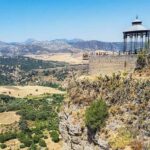Andalucia is one of the most culturally rich places in Spain and part of the historic monuments of the region are the gorgeous whitewashed villages, dotted around the county. Living here, I have visited so many of these beautiful pueblos blancos in Andalucia, and in this article I want to share with you the ones I loved the most.
Most of the prettiest white villages in Andalucia are scattered around Cadiz province, where in the 12th century the Moors built their defence system against the invaders. Today you can follow the route of the pueblos blancos in Cadiz, which runs through the Sierra de Grazalema National Park, grouping them together with some of the most important villages on a spectacular road trip.
Whilst the whitewashed villages in Andalucia are similar, their history and the landscape that they have been built around are different, each of them having a unique character and offering plenty of things to do and see.
Pueblos Blancos in Malaga:
Mijas Pueblo
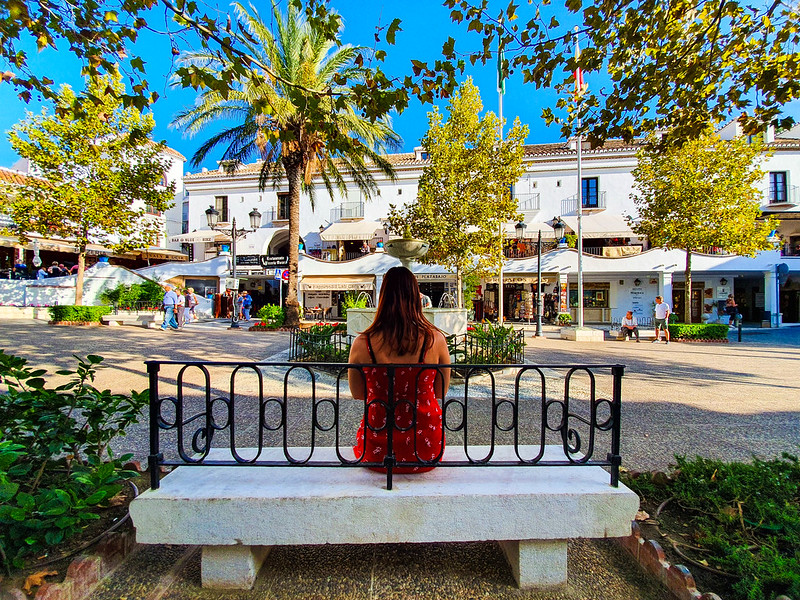
Over the past few years, Mijas Pueblo has become more and more popular with tourists. Being one of the closest pueblos blanco to Malaga and easily reachable by public transport, raised its popularity among day-trippers. However, this does not change the fact that this Andalucian whitewashed village is gorgeous and worth visiting.
There are so many things to do in Mijas Pueblo, starting with walking around its beautiful narrow streets which offer stunning views over the coast. Mijas Pueblo has a privileged location, on the side of the Sierra de Mijas Mountain range, which makes it a perfect place to watch the sunrise or the sunset from. On a clear day, you can see all the way to Morocco.
Mijas Pueblo makes a great day trip from Malaga because you can spend the entire day exploring its treasures, such as the miniature museum, the wine museum (where you can enjoy as much local wine as you can), or the local museum where you can find out about the “Mole from Mijas” – a man who lived inside a wall for three years, hiding away from Franco. There are also some amazing places to eat in Mijas Pueblo, from tapas bars to fine dining restaurants.
If you love hiking, Mijas has plenty of trails in the Sierra de Mijas, with the longest leading all the way to the meteorological station on top of the mountain.
Frigiliana

Frigiliana is a gorgeous whitewashed Andalucian village located 10 minutes’ drive away from Nerja. It makes a popular day trip from Nerja and no wonder, as it is so charming and picturesque.
There are plenty of things to do in Frigiliana, starting with taking in the views of the coast from the high viewpoints in the village. There are plenty of hidden corners in Frigiliana which you can find by exploring the village on foot.
If you love shopping for unique souvenirs, you will love Frigiliana. The village has plenty of small, boutique shops, selling artisanal products made by local artists.
Ojen
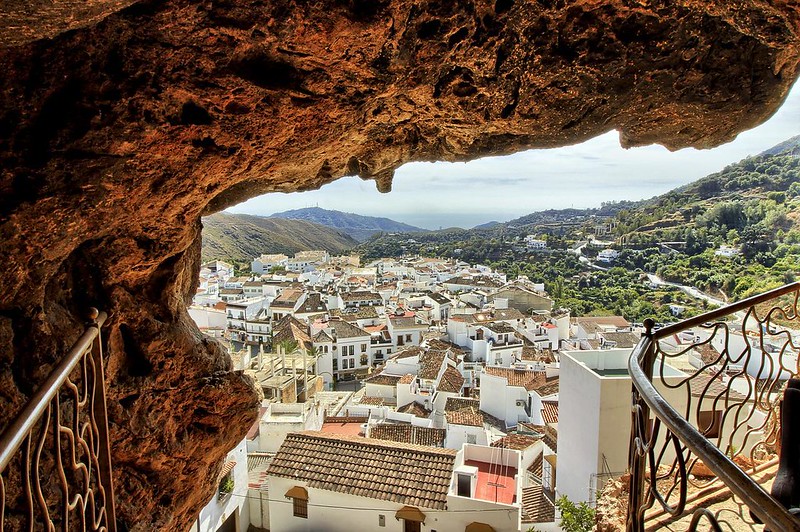
Ojen is a lovely white village tucked away in the Sierra Blanca mountains, 10 kilometres away from Marbella.
The village makes a great base if you want to combine a relaxing holiday surrounded by nature with activities such as hiking, climbing, or caving. Near Ojen you will find plenty of caves that are free to explore and also offer beautiful views over the village itself.
Ojen is also one of the gateways to the Sierra de las Nieves National Park, a fantastic ecosystem where you will find plenty of hiking trails to suit every fitness level.
The village is also famous for its yearly independent music festival which attracts over 15,000 visitors. In comparison, the village is home to only around 3,000 people.
Casares

Casares is a picture-perfect whitewashed Andalucian village located on top of a hill, close to Estepona. As you approach the village from the road you can’t help but stop and take a photo of this magnificent place.
The Castillo de Casares stands tall on top of a cliff, at the highest point in the village. Casares was developed around the castle, on the slopes downhill. There isn’t much left from the 12th-century castle, but if you climb up there you will have a gorgeous view over the village and its surroundings. On a clear day, you can even spot Gibraltar.
There are plenty of things to do in Casares, from strolling around the very narrow alleys to finding panoramic viewpoints. One of the prettiest churches in the village is Iglesia de San Sebastian, built at the crossroads of two alleys going uphill, just behind Plaza Espana.
Pueblos Blancos in Cadiz:
Olvera

Olvera is another beautiful pueblo blanco close to Ronda. It is famous for its majestic castle tower, offering gorgeous 360 degrees panoramic views over the valley below and the surrounding mountains.
Olvera is quite compact, with narrow roads that lead up to the castle. The Castillo Arabe de Olvera was built during the 12th century by the Moors, then rebuilt by the Christians after the village was conquered by the Kingdom of Castille in the 13th century. Because it was built over a cliff, the castle has a very irregular shape. You can visit the castle and climb its tower for 2 euros.
Just outside the castle you will find the Nuestra Señora de la Encarnación Church, which is unique in Andalucia because of its large size. Visiting it costs 2 euros.
Setenil de las Bodegas
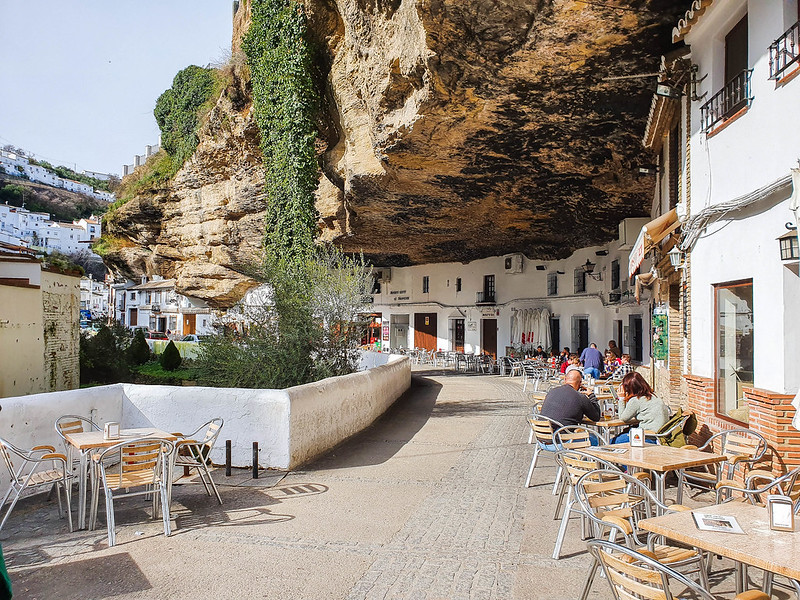
Setenil de las Bodegas is one of the most unique pueblos blancos in Andalucia. Whilst most of the whitewashed villages have been built on top of cliffs or hills, to protect the locals from invaders, Setenil de las Bodegas has been built inside a canyon.
A lot of the houses in Setenil de las Bodegas have been built directly into the rocks of the mountain. A few of the streets in the village are covered by massive boulders which fit perfectly above the houses beneath them. Quite a few of these homes have been transformed into B&Bs, where you can spend the night if you are looking for a unique experience.
As every other fortified white village in Andalucia, Setenil de las Bodegas has an Arab castle which was built in the 12th century for defence purposes. Back then, it had 40 towers, but only one remains today. You can visit the castle and its tower for 1 euro.
If you are in Setenil de las Bodegas only for a short time, don’t miss having lunch or dinner at one of the restaurants on Calle de las Cuevas.
Zahara de la Sierra
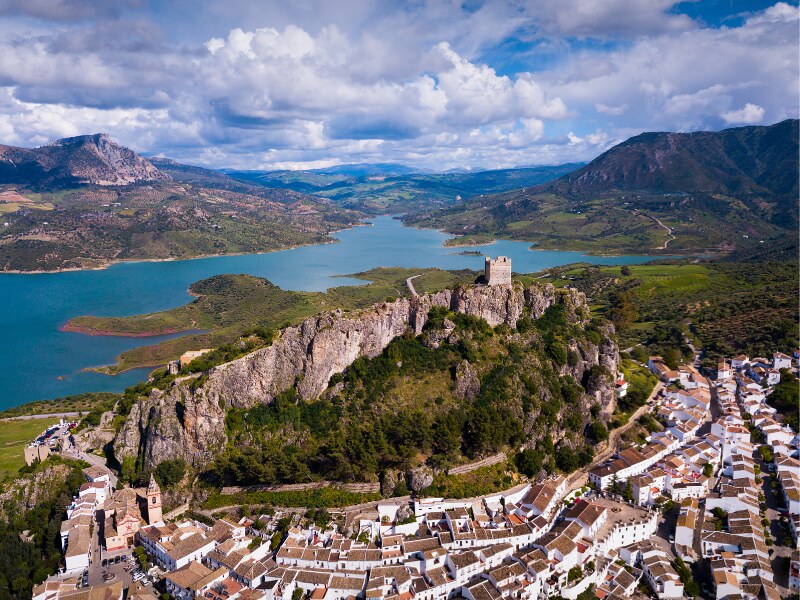
Zahara de la Sierra is a pueblo blanco that looks like it belongs in a fairytale. The setting of this village is so pretty that you won’t believe it’s real. Zahara de la Sierra is located on the side of a cliff, with its castle up the highest cliff on the mountain. On the other side, the village is overlooking the Emblase de Zahara – El Gastor reservoir.
There are plenty of things to do in Zahara de la Sierra, starting with its centre – Plaza Mayor. Here you will find most of the touristic attractions in the village, such as the Santa Maria de la Meza Church, the San Juan de Letran Chapel, the viewpoint and plenty of tapas bars where you can stop for a snack and a glass of wine.
If you love water sports, you can try kayaking, windsurfing and even jet-skiing in the reservoir.
Conil de la Frontera

Conil de la Frontera makes a wonderful day trip from Cadiz. This gorgeous fishing village is home to some of the most beautiful beaches near Cadiz and unspoiled scenery. Conil de la Frontera is a very popular summer destination for Spaniards, who choose it for its lively atmosphere and laid-back feel.
Conil de la Frontera was founded by Guzman el Bueno, the same Moorish Caliph who the Castle in Tarifa is named after. The tower in Conil de la Frontera also bears his name.
If you visit Conil de la Frontera you shouldn’t miss tasting the famous atun rojo (red tuna) which are caught there, which makes one of the best fish dishes in Andalucia. At the Chanca interpretation centre you can learn about the unique fishing method that is used to catch the tuna, which has been used since Roman times.
Vejer de la Frontera
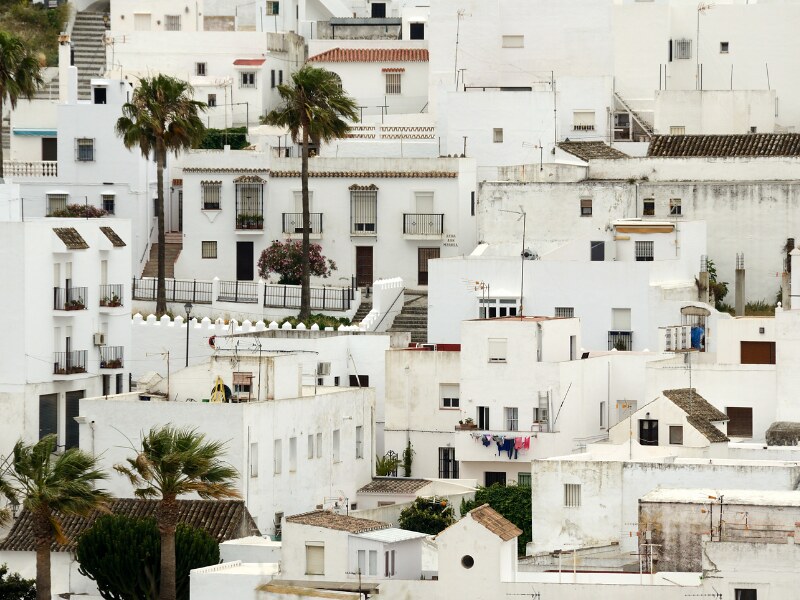
Just up the road from Conil de la Frontera, you will encounter Vejer de la Frontera, one of the most beautiful hilltop whitewashed Andalucian villages. From the several viewpoints in the village you can see all the way to Gibraltar, as well as admire the beautiful orange orchards surrounding Vejer.
Vejer de la Frontera is a lively village, with plenty of restaurants and bars where you can try the local tapas and have a glass of cold beer on a hot sunny summer day. In Plaza de Espana you can admire a beautiful fountain decorated with traditional Andalucian ceramic frogs. The entire fountain is like a work of art, plated with colourful tiles, resembling the same style as Plaza Espana in Seville.
What makes Vejer de la Frontera different from other white villages of Andalucia is the fact that you can observe its medieval history in the architecture of the monuments, as well as the old defence wall. To enter the historic centre of the village you have to pass through Arco de la Villa, an arch that was originally the main entrance to Vejer de la Frontera.
Arcos de la Frontera, Cadiz

Arcos de la Frontera is another dramatic pueblo blanco of Andalucia, part of the White Villages Touristic Route. Because of its spectacular architecture, the entire village was declared a national monument back in 1962.
Arcos de la Frontera was built on a very steep cliff, so expect some pretty amazing views over the landscape around it, over the Grazalema National Park. Don’t try driving up though, as the streets are very narrow and parking is almost impossible. Leave your car in the main car park, in the lower part of the town.
In Arcos de la Frontera you will see quite a few medieval churches, as well as 17th and 18th century palaces.
Grazalema
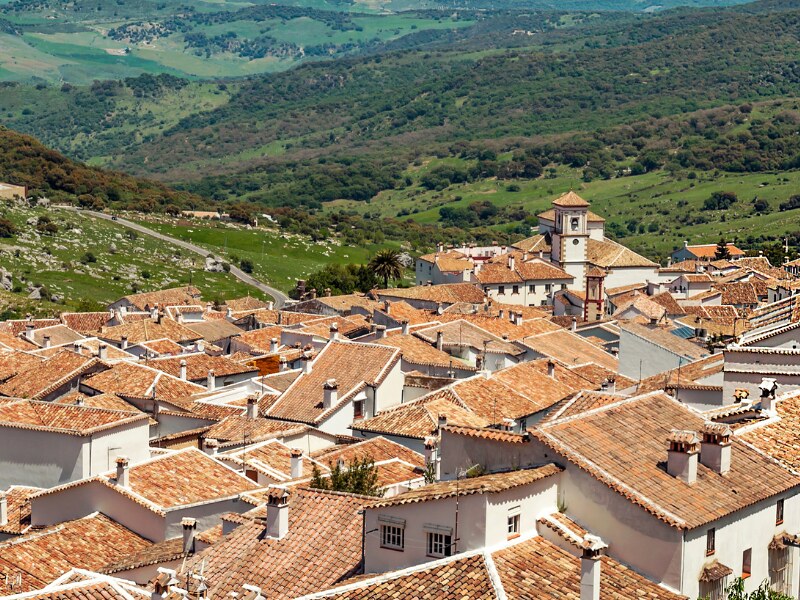
Grazalema is the gateway to Grazalema National Park, which offers lovely hiking trails, wildlife, and unique flora. The whitewashed village of Grazalema is small but vibrant, and sits in a gorgeous landscape, at the foothills of the Penon Grande rock formation.
The village is beautiful and well maintained, with pretty white houses decorated with pink bougainvillaea and red geranium flowers. The main square of the village, Plaza Espana, is a great place to try some of the local tapas and drinks, and just watch the people pass by.
When you visit Grazalema, make sure to look for the drinking water fountains. Some of them are as old as the Roman Empire, and still provide perfectly clean, drinking water.
Medina – Sidonia

Medina-Sidonia is a fortified pueblo blanco surrounded by medieval walls, one of the oldest in Europe. The village is a maze of narrow cobbled streets between tall, white decorative iron-fronted houses. The village also has three original Moorish gates, that provide access to the old historic town.
One of the most important monuments in Medina-Sidonia is the Santa Maria la Coronada Church, which dates from the 16th century and built in an Andalucian gothic style. The church was constructed over the ruins of an old mosque which was converted into a Mudejar style religious establishment after the Christian Reconquista.
Pueblos Blancos in Cordoba
Iznajar

Iznajar is a photographer’s dream. This picturesque pueblo blanco is located in Cordoba province, between Granada and Cordoba. To access the village from the main road you will have to cross a bridge over the water reservoir. Make sure you stop at the viewpoint before the bridge, so you can see the panorama of Iznajar reflected in the water.
Walking along the cobbled streets of Iznajar couldn’t be more romantic. Most of the white houses are decorated with bright blue pots filled with colourful geraniums.
The most popular touristic attraction in Iznajar is the castle, which sits on the highest point of the village. From up there you have a beautiful view over the olive tree orchards around, and the reservoir below.
Pueblos Blancos in Jaen
Cazorla

If you are planning to visit Jaen and are looking for a day trip to a pretty pueblo blanco, you must check out Cazorla. This pretty medieval white village is surrounded by mountains and lush pine forests.
Throughout history, the village had a very strategic position in the defence ring of the Al Andalus Empire. Even after the Reconquista, the village remained an important military point due to its location, high in the mountains.
There are plenty of things to see in Cazorla, starting with either the ruins of the old cathedral, the main square which is shaped like an egg, or the La Yedra Moorish castle.
Pueblos Blancos in Sevilla
El Coronil
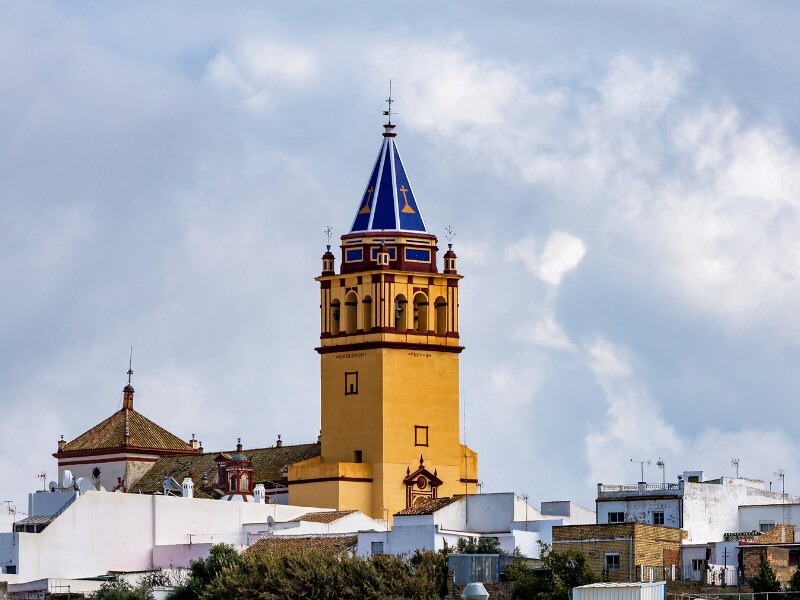
El Coronil is a pretty white village close to Sevilla, with pretty 18th century state palaces and two Arab castles that played an important part in the Moorish defence system.
One of the most important monuments in El Coronil is the Aguzaderas Castle, which every summer hosts a famous flamenco festival. The castle is located 3 kilometres outside the village centre.
Pueblos Blancos in Granada:
Pampaneira

Pampaneira is one of the most picturesque, whitewashed villages in the Alpujarras region of the Sierra Nevada mountains. The village has a population of just around 300 people, and it is always on the lists of the most beautiful villages in Spain.
The village is famous for its Berber architecture which consists of flat rooftops with typical chimneys, arched doorways, and houses covered in pink flowers. The village is famous for its textile industry, having plenty of small shops from where you can buy handmade blankets and rugs.
One of the places you must visit in Pampaneira, if you love chocolate, is Abuela Ili. This small artisan chocolatier creates exceptional products with South American cocoa combined with local produce from the mountains. For flavours that will take your taste buds on a journey, try their unique goat’s cheese white chocolate, or the dark lime chocolate. They also have a shop in Granada, which I also visited when I went on a food tour of the city.
Pampaneira is also a great base if you want to go hiking in the Sierra Nevada Mountains. There are plenty of trails that connect this village with the nearby Capileira and Bubion white villages.
Capileira

Capileira is the highest second highest village in mainland Spain, tucked away above the Poqueira Gorge in the Alpujarra region. It offers gorgeous views over the snow-capped peaks of the Sierra Nevada mountains, and it is a popular destination for hikers who want to ascend Mulhacen, the highest summit in continental Spain.
Capileira is part of an area of artistic and historical importance, a national Spanish heritage listing system meant to protect the historical sights. The village has a similar Moorish Berber architecture as Pampaneira. In Capileira you will find plenty of freshwater fountains, coming directly from the high areas of the mountains.
Vélez de Benaudalla, Granada
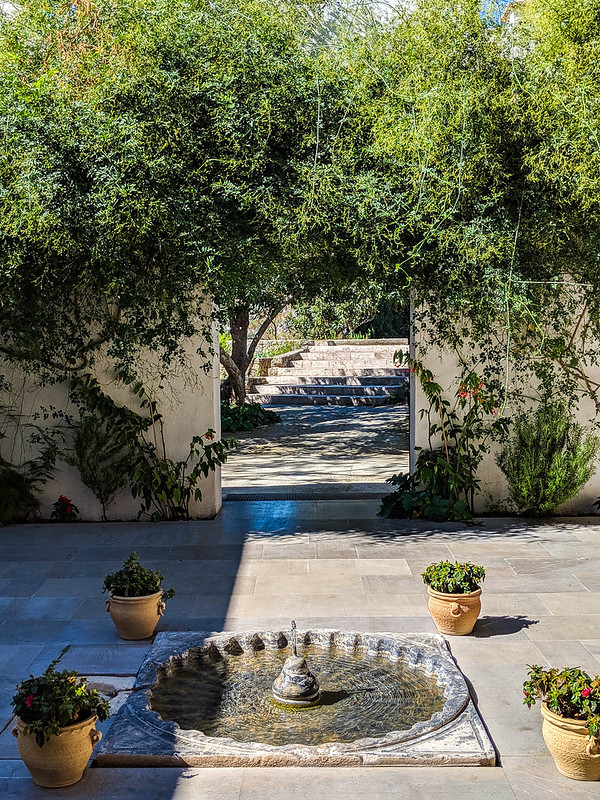
Vélez de Benaudalla is a very pretty white village close to Motril and Granada’s Costa Tropical. What makes this village special are the Nazari Gardens, a fantastic example of Moorish landscaping.
The gardens, hidden behind a tall wall, have been designed to represent all the main elements of a balanced life: spirit, aesthetics, psychology, nutrition and science. As you step into the garden you will notice the large palm trees, which are meant to represent life, and the man’s journey from birth – the ground, to heaven – the sky. Water, which represents the main vital element in life, is flowing through different parts of the garden. Jardin Nazari is also known by the name of “the Small Generalife” – which are the Alhambra’s gardens.
The garden has several sections: one for flowers, that please the eye, one for vegetables, that feed the body, and one for spices, that heal the body.
Vélez de Benaudalla is not on the touristic route, but it’s a great place to visit especially if you love traditional Arabic desserts such as pestiños or roscos.
Liked it? Pin it!

Disclaimer: Some of the links on this website are “affiliate links.” This means that if you click on the link and do a purchase, I will receive an affiliate commission at no extra cost to you. This helps me keep my website running and continue to share my travelling knowledge with you. I thank you for booking your flights or hotels using the links on my website. Regardless, I only recommend products or services I use personally and believe will add value to my readers.


